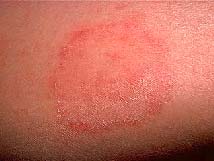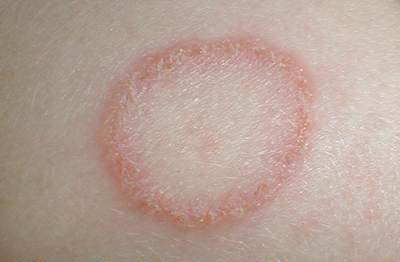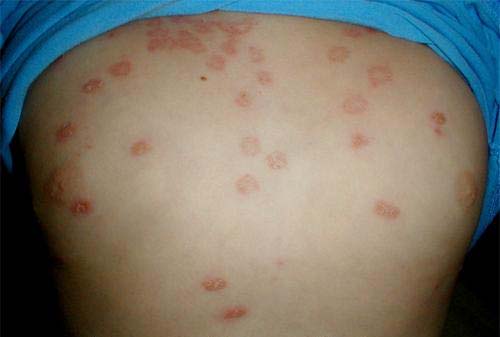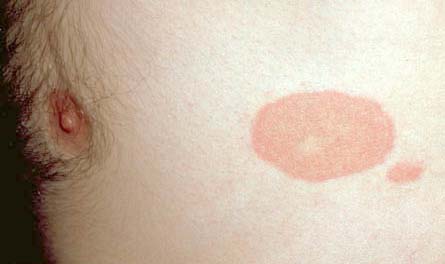Microsoft word - managingringwormjune8th,2005.doc
Managing Ringworm in the Sport of Judo
Report from Sports Medicine and Science Committee
Introduction
Due to the close contact inherent in the sport of judo, athletes are more
susceptible to skin disorder transmissions. Many types of skin disorders exist and we will not be able to cover them all in this report. The focus will be on one particular skin condition affecting many judo athletes over the past 3 years… "Ringworm".
It is important that everyone at risk of contracting ringworm understand the
condition, transmission, treatment and prevention in order to control outbreaks.
Ringworm needs to be taken seriously and this action plan is meant to stop the spread
of this fungal infection.
Condition
Fungal infections can be caused by different types of fungi (mushrooms) that can
affect the hair (Tinea Capitis), the skin (Tinea Corporis- usually called Ringworm), the nails (Tinea Unguium) and the feet (Tinea Pedis- usually referred to as the Athlete's Foot, a disease exclusive to humans) (11) Also, these infections can be caused by different kinds of microscopic organisms called dermatophytes. For example, the fungus usually responsible for athlete's foot is Trichophyton rubrum or Trichophyton
mentagrophytes, while ringworm on the skin is more associated with either Microsporum
canis or Trichophyton species. (6,17)
Transmission
The fungi responsible for these infections can be found on the floor (including
tatamis), animals and humans. These dermatophytes favourable environmental conditions are: moisture, darkness and temperatures above 30 degrees Celsius.(24)
The ringworm can be transmitted by direct or indirect contact from: animal-to-
animal, animal-to-human or human-to-human. Also, indirect contact of skin cells or hair
infected with the fungus and located on the floor, mats, judo gi or other clothing can
spread the condition easily to humans or animals.
The infectious period lasts as
long as the condition persists.(6)
Moreover, an animal (mostly cats and dogs) or
human could have the infection of one of the existing fungus without showing any
symptom on the skin (asymptomatic).(16)
Judo Canada Health Care Team May, 2005

Diagnosis
An itchy circular lesion usually
characterizes the ringworm, often
clear in the centre with rough, red,
scaly border. (16)
From skin contact with the fungus, ringworm lesions can appear within 4 to 10 days. The fungus has a preference for the head, neck and upper extremities. Less often it can affect trunk & lower extremities. (9) The size can vary from small circular lesions to very large patches if not treated. (21) Recognition of the condition can sometimes be mistaken with psoriasis, eczema, acne, herpes simplex, impetigo, etc. (9). For this reason, a physician should
(21) Figure 1
see the athlete immediately after
appearance of lesion for diagnosis and appropriate treatment.
Different tests exist to confirm a ringworm infection. A sample can be taken and put in a special petri dish called "Fungassay" containing the best condition for the ringworm fungi to grow. The disadvantage of this test is that it can take 10 to 14 days for the fungus to grow. (6)
(5) Figure 2
Another approach, the KOH test (4, 21), consists of scraping the lesion and examining the scales under a microscope to identify the specific fungus species.
Judo Canada Health Care Team May, 2005
It is important to realize that our skin (epidermis) contains 37 layers of cells.
Each day the top layer falls and a new one replace it at the bottom of the epidermis
layer. The fungus will usually hold onto the cells layers but could also be found on hair
or sometimes the hair follicles of the skin. So when a layer of infected skin cells falls, it
contains the ringworm that will live until it has nothing more to eat. (24) This is why it is
very important to treat not only the athlete, but also its environment including the dojo.
Treatment
The ideal treatment for ringworm should include: a visit to a physician for diagnosis and
definitive treatment with antifungal cream application or oral medication in more
serious cases (usually 2 or more lesions).
Application of antifungal cream should be done twice daily and last at least 3
weeks after lesions have disappeared (4, 22).
Popular antifungal creams over-the-counter are (4):
♦Miconazole (Monistat)
♦Clotrimazole (Mycelex)
♦Ketoconazole (Nizoral)
♦Terbinafine (Lamasil)
Most common oral treatment:
♦Griseofulvin (10)
♦Terbinafine (Lamisil)(4)
♦ Itraconazole (Sporanox)(4)
The treatments must include the affected athlete but also a screening of the rest of the family including animals. The environment should be often cleaned especially the bed sheets, judo gi and clothing.
The athlete should be restricted from training area and randori for 2 weeks. A physician's note should be required to return to training involving contact with other judokas. In fact, every club should have a designated physician for better treatment and control.
Covering a lesion with a bandage is ineffective in preventing transmission, and in fact could even be more harmful to the individual by providing favourable conditions for propagation.
During practice and training camps, methods to reduce skin abrasion and higher risks of contracting lesions could be employed (ie: "body armour" worn under judo gi by men and women ). Women judokas who wear t-shirts under their judo gi should use 100% cotton rather than 50-50 cotton- polyester blends.
Judo Canada Health Care Team May, 2005
OUTBREAK PREVENTION
When alerted to an outbreak…
a Judo Club should follow these guidelines:
•If an athlete presents with ringworm lesions, the athlete is isolated for 2 weeks
•A physician's note will be needed in order for the athlete to come back to the
club after the 2 week isolation period.
•All athletes in direct or indirect contact will have to wash their judo gi after
practice. Preventing transmission includes not sharing equipment or towels. Headgear must also be sanitized if worn by the athletes. (9)
•All locker rooms and hallways accessing the dojo should be disinfected with a
1:50 javel solution (bleach).
•Tatamis must be disinfected with a 1:50 javel solution (bleach) at the
end of each practice for a period of 2 weeks.
Mats must be swept before disinfection because organic material
decreases the efficacy of the sodium hypochlorite solution (javel) (14).
Sweeping the mats alone will not prevent an outbreak.
Tatamis cleaning procedures in prevention:
• Every Judo club's mats should be disinfected weekly with a 1:50 diluted javel
solution (usually 4-5% concentration). The diluted solution should be mixed
and used the same day. The solution should be mopped on and allowed to dry.
Mats should be swept daily. It is the responsibility of the club to ensure this
maintenance is performed even though a third party may be responsible for
general cleaning of the premises.
• During training camp, mats must be swept and disinfected every night with
freshly mixed 1:50 javel solution. Also, during training camps, the judo gi
should "ideally" be washed after every practice.
•During competition, mats must be swept and disinfected after every
competition day. *(A 1:10 javel solution is used to disinfect any blood spills)
Training camps:
•If an athlete presents with a ringworm lesion, the athlete should be isolated and
not permitted to participate. Training camps are breeding grounds for skin
lesion transmissions. Efforts at controlling outbreaks from visible lesions
should be encouraged.
Conclusion
Ringworm infection is a serious health concern. The collaboration of the entire
Judo community is required to control outbreaks and most importantly to prevent the
transmission to fellow athletes, friends, and family members.
Judo Canada Health Care Team May, 2005



Appendix: Photos
(18) Figure 3
(23) Figure 4
(15) Figure 5
Judo Canada Health Care Team May, 2005

(2) Figure 6
(20) Figure 7
(1) Figure 8
Judo Canada Health Care Team May, 2005


(19) Figure 9
(3) Figure 10
(7) Figure 11
Judo Canada Health Care Team May, 2005
1- aapredbook.aappublications.org/cgi/content/full/2003/1/3.129/133_01
2- aapredbook.aappublications.org/cgi/content/full/2003/1/3.129/133_06
3- aapredbook.aappublications.org/cgi/content/full/2003/1/3.129/133_07
4- dermatology.about.com/cs/fungalinfections/a/ringworm.htm
5- FAQ, Ringworm, What kind of infection is it?
6- Ikram and Hill, Microbiology for veterinary technicians, Mosby, United States of America, p. 151-157.
7- medlib.med.utah.edu/kw/derm/pages/in13_6.htm
8- Ringworm Update, Western Veterinary Conference 2003, Carol S Foil, MS, DVM, Dipl ACVD, Louisiana
State University, School of Veterinary Medicine, Dept. Vet. Clinical Sciences, Baton Rouge, LA, USA
9-The Physician and Sports Medicine, Fungal infection and parasitic infestations in sports, vol. 32, No. 10,
October 2004
10- WILLIAMS DI, MARTEN RH, SARKANY I.
11-www.aocd.org/skin/dermatologic_diseases/fungus_infections.html
12-www.eco-vie.com/a_ringworm.html
13-www.health.vic.gov.au/ideas/bluebook/ringworm.htm
14-www.lyon.inserm.fr/riskbio/decontamination/decontamination_javel.html
15-www.mayoclinic.com/invoke.cfm?id=DS00489
16-www.netdoctor.co.uk/diseases/facts/ringworm.htm
17-www.online-ambulance.com/articles/doc/2/grp/Dermatology/art/Ringworm.htm
18-www.skinatlas.com/tcorporis3.htm
19-www.skinatlas.com/tcorporis4.htm
20-www.skinatlas.com/tcorporis5.htm
21-www.skinsite.com/info_tinea_corporis.htm
22-www.wrestlingbhs.com/page18.html
23-Author's personal pictures.
24- Verbal communication: Dr. Wilkinson, dermatologist
Judo Canada graciously acknowledges the collaboration of Dr. James MacLachlan,
team physician for Wrestling Canada for reviewing this document.
Judo Canada Health Care Team May, 2005
Source: http://www.burnabyjudoclub.ca/documents/ringworm_management.pdf
Case 1:14-cv-04798-JMF Document 75 Filed 01/02/15 Page 1 of 30 UNITED STATES DISTRICT COURT SOUTHERN DISTRICT OF NEW YORK IN RE: MDL NO. 2543 GENERAL MOTORS LLC IGNITION ) 1:14-md-2543 (JMF) SWITCH LITIGATION HON. JESSE M. FURMAN
10 Sneaky Things a Spammer Will Do Just when you thought your inbox was safe… Table of Contents The Never Ending Growth of Email Spam A Reason for Spam and a Reason for More Spam 1 – Botnets, Zombies and You 2 – Borrowing a Reputation 3 – Spammers Can Authenticate Too 4 – Word Salad 5 – Light Reading 7 – If Only I Could Spell







